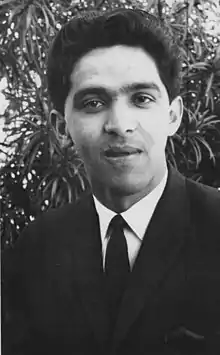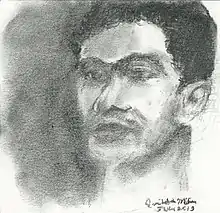Ahmed Timol
Ahmed Timol (3 November 1941 – 27 October 1971) was an anti-apartheid activist in the underground South African Communist Party. He died at the age of 29 from injuries sustained when he fell from the top floor of John Vorster Square police station in Johannesburg.[1] Police claimed, and an official inquest confirmed, that Timol had committed suicide by jumping out the window.[2] The claim was widely disbelieved in anti-apartheid circles, and in the movement Timol's death became symbolic of the broader phenomenon of deaths in police custody, as well as of the abuses and dishonesty of the apartheid state.[3][4]
Ahmed Timol | |
|---|---|
 | |
| Born | 3 November 1941 |
| Died | 27 October 1971 (aged 29) |
| Occupation | Teacher |
| Known for | Anti-apartheid activism |
| Honours | Order of Luthuli (silver) |
In 2017, the inquest into Timol's death was reopened. It found that Timol had been tortured in custody and had fallen from the window because he was pushed by police officers, not because he jumped.[5]
Biography
Timol was born in 1941 in Breyten, Transvaal (now part of Mpumalanga), into a large Muslim family of Gujarati descent.[6] Timol was one of six children, with two sisters, Zubeida and Aysha, and three brothers, Ismail, Mohammed and Haroon. His father, a shopkeeper, came to South Africa in 1918, at the age of 12, from the Kholvad district of Surat in western India.[7] Timol joined a semi-clandestine Roodepoort Youth Study Group while still a student at Johannesburg Indian High School,[8] and became friends at school with the brothers Aziz Pahad and Essop Pahad, both of whom would become prominent anti-apartheid activists.[9]

After working as a clerk for some years, Timol received a scholarship from the Kholvad Madressa in Surat to pursue a teaching course at the Johannesburg Training Institute for Indian Teachers, the only institution of higher education for Indians in the Transvaal at the time. He was Vice-Chairman of the Student Representative Council from 1962 to 1963, and the SRC became an affiliate of the National Union of South African Students in 1963.
After teaching for some time at a school in Roodepoort, in 1966 Timol left South Africa for Mecca for the Hajj. In Saudi Arabia, he met and was inspired by Yusuf Dadoo, leader of the Transvaal Indian Congress and later the Chairman of the South African Communist Party (SACP), and Moulvi Cachalia, an African National Congress (ANC) stalwart.[7] In April 1967, Timol went London, where he lived with the Pahads.[10] He took up a teaching post at the Immigration School at Slough, which provided him with funds, became an active member of the National Union of Teachers and met Ruth Longoni, who worked for the Labour Monthly, a journal run by Rajani Palme Dutt of the Communist Party of Great Britain. The two came close to marrying, but Timol left for Moscow in the Soviet Union in 1969, as he had been selected to study at the International Lenin School. He was trained in Marxist-Leninist ideology, along with three fellow South Africans, one of them Thabo Mbeki, then a communist, later South African state president.[11] After completing his training, Timol returned to London and received additional training for four weeks from Jack Hodgson, an SACP member in exile.
In February 1970, Timol returned to Roodepoort and resumed teaching. He was active in the SACP and in Umkhonto we Sizwe (MK), the paramilitary wing of the ANC, though both had been banned in 1960. His political work included recruitment for the ANC, MK and SACP, producing and distributing pamphlets, and procuring equipment for underground structures.[12][7]
Death
In October 1971, aged 29, Timol was arrested at a roadblock. According to the police, officers founded banned ANC and SACP literature, as well as copies of secret communication correspondence, in the boot of the car he was travelling in.[7][2] He was detained under the Terrorism Act of 1967 with Amina Desai and two others, all of whom later said that they had been severely tortured in custody.[13] He died on 27 October, five days after his arrest, from injuries sustained when he fell from the tenth floor of John Vorster Square police station in Johannesburg. He was the first political detainee to die in Security Branch custody at John Vorster Square. The police claimed that he had jumped from a window, which his family disputed in the press.[14] His death sparked nationwide shock, anger and demands for an inquiry. Support for such an inquiry came from a broad spectrum of the South African population that included the United Party (UP), various churches, the black South African Students Association, the Coloured Labour Party, and the Indian Congresses. In Durban, a packed meeting attended by people of all races called for a national day of mourning, which was observed on 10 November 1971.
An official inquest in 1972 ruled that his death had been a suicide.[1] The presiding magistrate suggested that Timol had killed himself after disclosing sensitive information during interrogation, because he feared imprisonment, and because the SACP had instructed its members to kill themselves before betraying the party.[10][2]
Timol's family and others testified about his death at the Truth and Reconciliation Commission (TRC), and the TRC ultimately assigned responsibility for Timol's death to several policemen. It also found that "the inquest magistrate's failure to hold the police responsible for Ahmed Timol's death contributed to a culture of impunity that led to further gross human rights violations."[13]
He was himself the light in a darkening room... The apartheid regime had banned us a decade earlier and had brutally set out to break and torture our scattered comrades. They believed that they had broken the back of the underground. And then they found Ahmed. Mayibuye! ["May it return!"] They performed upon his body a macabre dance, a danse macabre of exorcism through violence. It was their own neurosis that spoke through every blow, because in him our revolutionary spirit was made flesh and they simply could not believe it. He was and remained, even after his death, the spectre that was haunting South Africa.
– Thabo Mbeki on Timol[6]
2017 inquest
The inquest was reopened in 2017 at the request of Timol's family. George Bizos was part of the team representing Timol's family, as he had been in the original 1972 inquest.[1][15] In October 2017, the second inquest found that Timol had been pushed out the window or off the roof by members of the Security Branch. The inquest also heard evidence that Timol had been tortured during his detention, including from Salim Essop, who had been detained and tortured alongside Timol but whose testimony had been excluded from the original inquest.[5][16] The presiding Judge said that the officers holding Timol in custody were collectively responsible for his death, and that there was a prima facie case of murder under dolus eventualis against the two officers who had interrogated Timol that day, both of whom had died years earlier.[1][16] One surviving officer, Joao Rodrigues, died in September 2021 while facing a murder charge for Timol's death.[17]
Legacy
On 29 March 1999, President Nelson Mandela attended a ceremony at which Azaadville Second School in Krugersdorp was renamed after Timol.[18] President Jacob Zuma posthumously awarded him the Order of Luthuli (Silver) in 2009,"for his excellent contribution and selfless sacrifice in the struggle against apartheid."[19][20]

In the media
The Chris Van Wyk poem "In Detention" (1979) is a satire of the explanations given to cover up Timol's Death Indians Can't Fly (2015), directed by Enver Samuel, is a documentary about Timol. The follow-up Someone to Blame – The Ahmed Timol Inquest (2018), also directed by Samuel, focuses on the reopening of the inquest.
References
- Nicolson, Greg (12 October 2017). "Timol Inquest: He was murdered but culprits are dead, court rules". Daily Maverick. Retrieved 28 November 2021.
- "Inquest judgement". Historical Papers Research Archive (in Afrikaans). Wits University. 22 June 1972. Retrieved 28 November 2021.
- "Heroes of yesterday and today". Weekend Argus. 12 December 2009. Retrieved 28 November 2021.
- Thomas, Kylie (3 July 2021). "Digital Visual Activism: Photography and the Re-Opening of the Unresolved Truth and Reconciliation Commission Cases in Post-Apartheid South Africa". Photography and Culture. 14 (3): 297–318. doi:10.1080/17514517.2021.1927370. ISSN 1751-4517. S2CID 237518037.
- Burke, Jason (12 October 2017). "South Africa judge rules police murdered anti-apartheid activist in 1971". The Guardian. ISSN 0261-3077. Retrieved 12 October 2017.
- Cajee, Imtiaz (2005). Timol: A Quest for Justice. STE. ISBN 978-1-919855-40-0.
- "Ahmed Timol". South African History Online. Retrieved 28 August 2013.
- Vadi, Zaakira (26 October 2015). "Timol, a proponent of equal education". IOL. Retrieved 28 November 2021.
- Gee, Frank (18 June 2021). Justice for All. Dorrance Publishing. ISBN 978-1-64804-943-9.
- "Human rights violations hearings: Hawa Timol". Truth and Reconciliation Commission. 30 April 1996. Retrieved 28 November 2021.
- Gevisser, Mark (2009). A legacy of liberation Thabo Mbeki and the future of the South African dream (1st ed.). New York: Palgrave Macmillan. p. 1. ISBN 978-0230620209. Retrieved 28 September 2013.
ahmed timol, moscow.
- South African Democracy Education Trust (2006). The road to democracy in South Africa (1st ed.). Pretoria: Unisa Press. p. 440. ISBN 1868884066.
- "Report of the Truth and Reconciliation Commission, Volume 3". SABC. Retrieved 28 November 2021.
- Crouse, Gabriel; Myburgh, James (23 October 2017). "Salim Essop's ordeal (II)". Politicsweb. Retrieved 28 November 2021.
- Mabena, Sipho (12 October 2017). "Timol judgment: Bizo's tears of closure". Sunday Times. Retrieved 28 November 2021.
- Myburgh, James (17 October 2017). "The Ahmed Timol case (I)". Politicsweb. Retrieved 28 November 2021.
- Mabuza, Ernet (7 September 2021). "Ahmed Timol murder accused Joao Rodrigues dies". Sunday Times. Retrieved 28 November 2021.
- "School named after Ahmed Timol". The Mail & Guardian. 29 March 1999. Retrieved 28 November 2021.
- Saeed, Abdullah (17 December 2009). "Letter: Honouring a struggle hero". Witness. Archived from the original on 9 November 2014. Retrieved 12 October 2017.
- "Presidency unveils National Orders recipients". South African Government. 2 December 2009. Retrieved 28 November 2021.